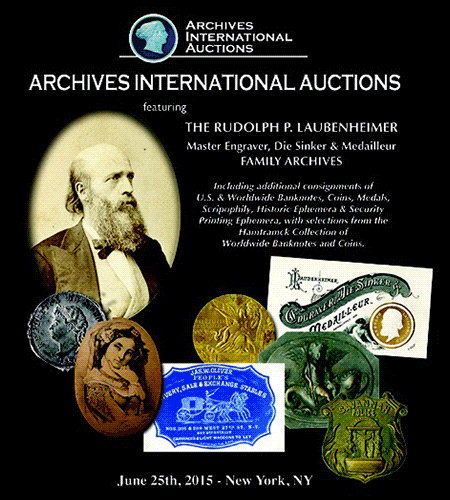Rudolph P. Laubenheimer: An Unusual Opportunity for they who think out-of-the-box
- by Bruce E. McKinney

In the broad categories of books, manuscripts, maps and ephemera there are many ways to parse available material. The most common ones are by subject, author, form and date range. Less common are the collections of the practitioners of the underlying arts supporting many aspects of the works in paper field. As a consequence such material is rarely collected because it is rarely available. In the upcoming sale at Archives International Auctions on June 25th in New York City, there is the rare opportunity to bid on the life work of Rudolph P. Laubenheimer, Engraver, Die Sinker and Medailleur, one of the leading representatives in the United States in his field from 1858 until his death in 1905. He was apparently as meticulous in his record keeping as he was in the execution of the engravings that were his stock in trade for over 50 years. We know this because his extensive personal papers and archives are being offered at Archives International on June 25th.
Though this collection should ideally be left intact in a suitable institution due to its unique nature, alas, it is to be scattered to the 4 corners, thus allowing institutions and collectors to bid on individual lots – some 474 of them. No one is sure what this material is worth and as a consequence the auction house, with the agreement of the consignors, have placed very reasonable estimates that ensure all lots will be sold. They of course hope the bidding goes higher but no one really knows because it’s a complicated sale.
The range of material includes examples of every type of artwork he executed and his range explained in the introduction to the sale catalogue:
Rudolph’s prolific career spanning 5 decades included designing and fabricating dies for the state seals of New York, Virginia, Maryland, Washington and North Carolina. He was also noted for his extensive Civil War token designs; cameo business and corner cards; U.S., Central and South American postal stationary dies and designs including the 1870 U.S. postal stationary series in which he received a commendation by the U.S. Post Office Department; medal and die production for the Centennial Exhibition held in Philadelphia in 1876 and the Columbian Exposition in 1892 as well as numerous medals, tokens, advertising medals, jewelry and decorative designs for various events, topics and causes. He designed, engraved and created dies for coins of Colombia; coats of arms for numerous countries and entities; as well as jewelry dies and decorative objects including various badges for police and fire departments as well as belt buckles including ones for the military. His lithography and engraving work, as well as paintings, sketches and drawings including portraits of many of his friends, still life drawings and paintings and various designs and images used in his craft as well as hundreds of other related items have never previously been offered to the collecting public. On his card he printed “Only the finest and most artistic work is executed and all orders are filled without delay.”
Occasionally such archives are sold. Years ago I was offered roughly 200 watercolors and sketches executed in the 1848-1860 period by Frederick Copley, not the famous Frederick and probably not even a relative but nevertheless an accomplished artist with a clear eye for detail and dimension. His material was also difficult to value; it too falling outside of the known categories but it also undeniably valuable. I bought it immediately and today count it among the best purchases of my collecting career.
One hopes some few self-confident curators; collectors and dealers will see the value in this material. Some of course will, the only question is how many. As there are many lots, if the number of bidders is less than the material deserves, the prices may fall well below what they are really worth. For those who bid regularly at auction this is what you hope for. If you are the consignor this is what you worry about.
It will be an interesting sale for what it tells us about non-traditional material. The sale is being widely advertised but so were the early exhibits of French Impressionism that failed to attract an interested audience. Sometimes material arrives before the community’s understanding. Some people are going to do very well in this sale. I just don’t know if it will be the buyers, sellers or, one hopes, both.
Here is a link to the sale.